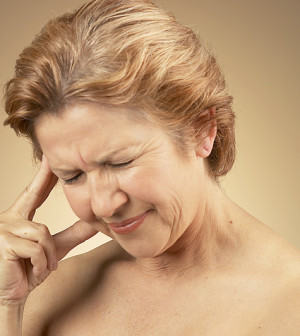- Double Mastectomy May Offer No Survival Benefit to Women With Breast Cancer
- Toxic Lead Found in Cinnamon Product, FDA Says
- Certain Abbott Blood Sugar Monitors May Give Incorrect Readings
- Athletes Can Expect High Ozone, Pollen Counts for Paris Olympics
- Fake Oxycontin Pills Widespread and Potentially Deadly: Report
- Shingles Vaccine Could Lower Dementia Risk
- Your Odds for Accidental Gun Death Rise Greatly in Certain States
- Kids From Poorer Families Less Likely to Survive Cancer
- Tough Workouts Won’t Trigger Cardiac Arrest in Folks With Long QT Syndrome
- At-Home Colon Cancer Test Can Save Lives
Migraines May Worsen During Menopause


New research confirms what women with migraine headaches have told their doctors for years: migraine attacks seem to get worse in the years before and during menopause.
“In women who have migraine, headaches increase by 50 to 60 percent when they go through the perimenopause and menopausal time periods,” said Dr. Vincent Martin, professor of medicine and co-director of the Headache and Facial Pain Program at the University of Cincinnati.
The new finding, Martin said, “basically confirms what women have been telling us physicians for decades. We finally have some evidence.”
The perimenopausal period is the time when the body is transitioning to menopause — when monthly periods end. Perimenopause can last several years, and is often marked by irregular periods, hot flashes and sleep problems. Perimenopause can begin in the 40s, and menopause occurs, on average, at age 51, according to the U.S. National Institute on Aging.
The study is due to be presented on Wednesday at the American Headache Society annual meeting in Los Angeles. Findings presented at meetings are generally considered preliminary until they’ve been published in a peer-reviewed journal.
Martin and his colleagues surveyed just over 3,600 women, aged 35 to 65, in a mailed questionnaire that asked about their menopausal status and whether they had migraines and, if they did, how often. The women were classified as having high frequency headaches if they had 10 or more headache days a month.
The women in the study were about evenly divided among the three groups: premenopausal, perimenopausal and postmenopausal.
While 8 percent of the premenopausal group had frequent headaches, 12.2 percent of the perimenopausal group did along with 12 percent of the menopausal women.
At first, the results might seem puzzling, since experts know that younger women often get migraines right before and at the beginning of the menstrual cycle, said study researcher Dr. Richard Lipton, director of the Montefiore Medical Center Headache Center and professor of neurology at the Albert Einstein College of Medicine, in New York City.
“Women with migraine are most likely to get them a couple days before bleeding through the first few days of the cycle, when estrogen and progesterone both fall. The idea that women who have fewer periods [during perimenopause] would get more migraines seems paradoxical,” said Lipton.
However, he said, experts believe decreasing estrogen levels explain the headaches in both cases.
The study provides welcome information on the problem of migraines, according to Dr. Elizabeth Loder, chief of the division of headache and pain in the department of neurology at Brigham & Women’s Hospital in Boston.
“I think this study is particularly valuable because they went to the trouble of carefully determining what phase the women were in,” she said.
Loder agreed that the study validates what patients have been telling doctors for years. Its size also lends credibility.
However, she said, it’s important to put the study in perspective. “Although the relative differences [in headache frequency] between groups look big, the absolute numbers are not,” Loder said. She pointed out that 8 percent of premenopausal women and about 12 percent of older women had frequent headaches.
For relief, Martin suggested, women could ask their headache specialist about adjusting or switching their migraine medicine.
The women might also ask about taking hormone replacement therapy for a brief time, he added, reasoning that raising estrogen might help decrease headaches. However, women and their doctors should discuss the benefits and the risks — such as an increased risk of stroke — with hormone use.
More information
To learn more about migraines, visit the U.S. Department of Health and Human Services.
Source: HealthDay
Copyright © 2024 HealthDay. All rights reserved.










